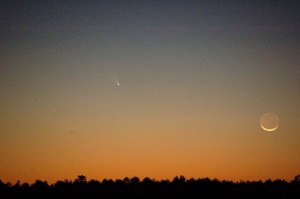Comet C/2011 L4 (PANSTARRS) was discovered by University of Hawai’i astronomers using the first commissioned telescope of the Panoramic Survey Telescope and Rapid Response System (Pan-STARRS). The comet, discovered in June 2011, has been visible in the southern hemisphere since discovery but since perihelion on the 10th of March 2013, the comet has made it to the northern hemisphere. Visible low on the western horizon just after sunset, the comet is slowly working its way toward the north and farther from the sun. This also means it has been slowly dimming as the distance from the sun increases.
The comet was too low on the horizon to be visible from the observatory so a field trip was in order. There is a military dropzone just south of I-10 on FL Hwy-285. The field is kept very clear and the far side of the area is a tree line a half-mile away allowing for a very low horizon. I could not find the comet with eyes only but the proximity of the crescent moon allowed finding the comet with binoculars. The comet was quite bright and I am convinced younger eyes would have had no problem seeing the comet without assistance. Currently, the comet is slowly moving north and by the last week of May will be near Polaris. It will also be too dim to see naked-eye but at a predicted magnitude of 9.3 will be an easy telescopic target.
This image is a single 3 second exposure taken with a tripod mounted Nikon D50.

Daughter and I tried at the beach several times to see the comet but to no avail. We did not use binoculars which was probably the reasons. Looking forward to this Nov and the next one!